Control grazing and strip grazing
The basic principle of control grazing is to allow goats to graze for a limited time, leaving a leafy stubble, and then to move them to another pasture, a paddock or sub-paddock. Smaller paddocks are more uniformly grazed and surplus paddocks can be harvested for hay. The pasture forage plants, with some leaves still attached, can then use the energy from the sun through photosynthesis to grow back without using up all of their root reserves. Even brush will need a recovery time if it is being used as forage for goats. Without this rest period, the goats can kill the brush through continuous browsing.
Under control grazing, legumes and native grasses may reappear in the pasture, and producers often report that the pasture plant community becomes more diverse. Control grazing can be used to improve the pasture, extend the grazing season, and enable the producer to provide a higher quality forage at a lower cost with fewer purchased inputs. Control grazing can also be useful in reducing internal parasite problems, if meat goat producers are careful to move the goats to a new pasture before the forage plants are grazed too short, that is, less than about 4 inches. In addition, the use of the FAMACHA system to selectively deworm goats will overcome the problems of pasture infestations by resistant intestinal nematodes, due to increased refugia. Refugia is the proportion of nematodes that provide a pool of susceptible genes and dilute dewormer-resistant genes in that population.
Strip grazing can be easily superimposed on control grazing in large paddocks by placing movable electric fences ahead and behind the goats, giving them sufficient forage for two to three days. Strip grazing is very effective and results in high pasture utilization because otherwise goats will not graze soiled forage well. Strip grazing results in high average daily gain, increased gain per acre, and rapid improvement of body condition when pasture is vegetative and excellent quality, especially during cool weather. Strip grazing is very effective with stockpiled fescue during late fall and early winter. The practice is not recommended when pasture is of low quality because of reduced goat selectivity.
Luginbuhl, J-M. 2006. Pastures for Meat Goats. In: Meat Goat Production Handbook, ed. T.A. Gipson, R.C. Merkel, K. Williams, and T. Sahlu, Langston University, ISBN 1-880667-04-5.


